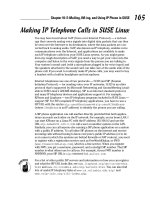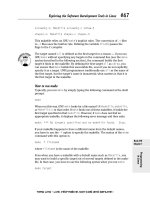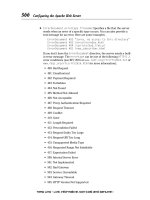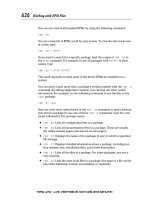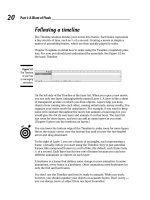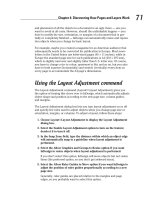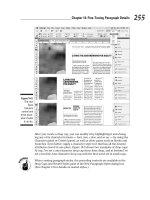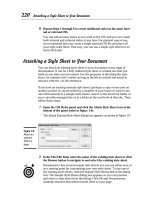Oracle PL/SQL for dummies phần 7 ppsx
Bạn đang xem bản rút gọn của tài liệu. Xem và tải ngay bản đầy đủ của tài liệu tại đây (849.79 KB, 44 trang )
SUBSTR is needed if you want to retrieve part of existing string, as shown
here:
v_tx:= substr(string, start position[,number of chars]);
The start position could be either a positive or negative integer. This would
start counting the position from the beginning or from the end of the string,
as shown here:
SQL> declare
2 v1_tx VARCHAR2(5):=’ABCDE’;
3 v2_tx VARCHAR2(5);
4 begin
5 v2_tx:=substr(v1_tx,2);
6 DBMS_OUTPUT.put_line(v2_tx);
7 v2_tx:=substr(v1_tx,-2);
8 DBMS_OUTPUT.put_line(v2_tx);
9 end;
10 /
BCDE
DE
PL/SQL procedure successfully completed.
SQL>
As shown in these examples, you can omit the third parameter (requested
number of characters). In that case, Oracle returns everything from the point
you specified to the end of the string. If your starting point is more than the
total number of characters in the string, Oracle returns NULL.
The number of characters requested from the string might not always be the
length of the resulting string. It could be less, because you might request more
characters than the string has. In that case, Oracle just returns everything up
to the end of the string, as shown in Listing 10-18.
Listing 10-18: Using SUBSTR
SQL> declare
2 v1_tx VARCHAR2(5):=’ABCDE’;
3 v2_tx VARCHAR2(5);
4 begin
5 v2_tx:=substr(v1_tx,2,2);
➞
5
6 DBMS_OUTPUT.put_line(v2_tx);
7 v2_tx:=substr(v1_tx,2,7);
➞
7
8 DBMS_OUTPUT.put_line(v2_tx);
9 end;
10 /
BC
➞
11
BCDE
➞
12
PL/SQL procedure successfully completed.
SQL>
246
Part IV: PL/SQL Data Manipulations
17_599577 ch10.qxp 5/1/06 12:23 PM Page 246
Additional information about Listing 10-18 is shown here:
➞
5, 11 The code works perfectly because you requested two characters
and two characters were returned.
➞
7, 12 This line requested 7 characters, and 4 were returned because
only 5 characters were in the original string.
The function INSTR allows you to locate one string/character in the other
one. You can declare it as shown here:
v_nr:= instr(string,substring[,position,occurrence]);
At the simplest level, INSTR returns the number of characters in the original
string where the desired substring starts. But you can also specify the posi-
tion from which you want the search to start (by default from the first charac-
ter) and what occurrence of the desired string is required (by default, the
first one), as shown in Listing 10-19.
Listing 10-19: Using INSTR
SQL> declare
2 v1_tx VARCHAR2(20):=’Hello, World!’;
3 v_nr binary_integer;
4 begin
5 v_nr:= instr (v1_tx,’l’);
➞
5
6 DBMS_OUTPUT.put_line(v_nr);
7 v_nr:= instr (v1_tx,’l’,-2);
➞
7
8 DBMS_OUTPUT.put_line(v_nr);
9 v_nr:= instr (v1_tx,’l’,2,2);
➞
9
10 DBMS_OUTPUT.put_line(v_nr);
11 end;
12 /
3
➞
13
11
➞
14
4
➞
15
PL/SQL procedure successfully completed.
SQL>
Listing 10-19 works as shown here:
➞
5, 13 There are three occurrences of the letter ‘l’ in the original string.
In the first case, you’re getting the position of first letter starting
from the beginning (default).
➞
7, 14 These lines of code retrieve the first occurrence of the letter ‘l’
starting from the second character at the end in reverse order.
You can have both positive and negative starting positions as in
SUBSTR, but here it means not only the starting point, but also the
direction of the search.
247
Chapter 10: Basic Datatypes
17_599577 ch10.qxp 5/1/06 12:23 PM Page 247
➞
9, 15 These lines get the second occurrence of the letter ‘l’, starting
from the second character.
You’ll often use both SUBSTR and INSTR at the same time, especially for
parsing text. For example, to print out the last word in the string, you can use
the following code:
SQL> declare
2 v1_tx VARCHAR2(20):=’Hello to everybody’;
3 v2_tx VARCHAR2(20);
4 begin
5 v2_tx:= substr (v1_tx, instr (v1_tx,’ ‘,-1)+1);
6 DBMS_OUTPUT.put_line(v2_tx);
7 end;
8 /
everybody
PL/SQL procedure successfully completed.
SQL>
Even though this is an oversimplified case (you are taking everything from
the last blank character to the end), it is absolutely correct. First, you need to
find the position of the last space character by using INSTR, and second, you
need to use SUBSTR to grab the rest of the string — starting with the next
character from the one you found and going to the end of the original string.
REPLACE and TRANSLATE
The REPLACE and TRANSLATE functions allow you to transform text by using
the specified pattern shown here:
v_tx:= replace(string,search[,replacement]);
v_tx:= translate(string, search, replacement);
Although these functions look similar, there is a major difference. The
REPLACE function changes one string to another string, as shown here:
SQL> declare
2 v1_tx VARCHAR2(20):=’To be or not to be’;
3 v2_tx VARCHAR2(20);
4 begin
5 DBMS_OUTPUT.put_line(‘Before: ‘ || v1_tx);
6 v2_tx:= replace (v1_tx,’be’,’eat’);
7 DBMS_OUTPUT.put_line(‘After: ‘ || v2_tx);
8* end;
9 /
Before: To be or not to be
After: To eat or not to eat
PL/SQL procedure successfully completed.
SQL>
248
Part IV: PL/SQL Data Manipulations
17_599577 ch10.qxp 5/1/06 12:23 PM Page 248
If you don’t specify the third parameter, Oracle just removes all occurrences
of the search string. This is very useful if you want to remove all the spaces
from the text.
The TRANSLATE function takes search and replacement strings and creates
character-to-character maps (the first character from the search string
should be replaced with first character from the replacement string, and so
on), as shown here:
SQL> declare
2 v1_tx VARCHAR2(20):=’To be or not to be’;
3 v2_tx VARCHAR2(20);
4 begin
5 v2_tx:= translate (v1_tx,’bo ‘,’BO’);
6 DBMS_OUTPUT.put_line(v2_tx);
7 end;
8 /
TOBeOrnOttOBe
PL/SQL procedure successfully completed.
SQL>
If you have more characters in the source string than in the replacement
string, those characters are removed. As in the example, because the replace-
ment string has only two characters, the third character from the source
string is gone. No spaces appear in the result.
With the TRANSLATE function, the third parameter (the replacement charac-
ters) can’t be NULL or an empty string. Otherwise, the result is always NULL.
*PAD and *TRIM
A number of functions allow you to either add (PAD) or remove (TRIM) char-
acters to an existing string: LPAD/LTRIM do it from the left side of the string,
RPAD/PTRIM from the right side. Also, a wrapper function, TRIM, allows you
to select the trimming mode (left side – leading /right side – trailing /both) as
shown in Listing 10-20.
Listing 10-20: Using LPAD and LTRIM
v_tx:= lpad(string,length,extra string);
v_tx:= ltrim(string [,character]);
v_tx:= trim(LEADING|TRAILING|BOTH character from string);
SQL> declare
2 v1_tx VARCHAR2(20):=’Hello!’;
3 v2_tx VARCHAR2(20);
4 v3_tx VARCHAR2(20);
5 begin
(continued)
249
Chapter 10: Basic Datatypes
17_599577 ch10.qxp 5/1/06 12:23 PM Page 249
Listing 10-20
(continued)
6 v2_tx:= rpad(lpad(v1_tx,10,’*’),15,’*’);
➞
6
7 DBMS_OUTPUT.put_line(v2_tx);
8
9 v3_tx:= trim (both ‘*’ from v2_tx);
➞
9
10 DBMS_OUTPUT.put_line(v3_tx);
11 v3_tx:= trim (leading ‘*’ from v2_tx);
➞
11
12 DBMS_OUTPUT.put_line(v3_tx);
13 v3_tx:= trim (trailing ‘*’ from v2_tx);
➞
13
14 DBMS_OUTPUT.put_line(v3_tx);
15 end;
16 /
****Hello!*****
Hello!
Hello!*****
****Hello!
PL/SQL procedure successfully completed.
SQL>
Here’s what you see in Listing 10-20:
➞
6 This code pads the original string with * from the left and right
sides.
➞
9 This code represents the most popular way of using the function
TRIM by trimming specified character from both sides.
➞
11 This code represents trimming of leading characters using exactly
the same functionality as LTRIM.
➞
13 This code represents trimming of trailing characters using exactly
the same functionality as RTRIM.
Unless you are using Oracle 8i, the TRIM function is recommended instead of
the older LTRIM/RTRIM because it provides greater flexibility and readability
of the code.
Extending your options with
regular expressions
In 10g, Oracle introduced regular expressions, which allow you to search for
patterns in string data by using a very rich syntax. This syntax is becoming
standard throughout the IT industry.
Regular expressions cannot be used as parameters in the standard Oracle
built-in text search functions: LIKE, SUBSTR, INSTR, and REPLACE. Instead,
250
Part IV: PL/SQL Data Manipulations
17_599577 ch10.qxp 5/1/06 12:23 PM Page 250
regular expressions have their own versions of the same functions: REGEXP_
LIKE, REGEXP_SUBSTR, REGEXP_INSTR, and REGEXP_REPLACE.
As an example, in regular expressions, the special character | defines an OR
condition for the characters surrounding it, as shown here:
SQL> declare
2 v1_tx VARCHAR2(2000):=’*ABC*BBC*’;
3 begin
4 DBMS_OUTPUT.put_line(‘First hit:’||
5 REGEXP_INSTR(V1_TX,’A|BBC’,1,1));
➞
5
6 DBMS_OUTPUT.put_line(‘Second hit:’||
7 REGEXP_INSTR(V1_TX,’A|BBC’,1,2));
➞
7
8 end;
9 /
First hit:2
Second hit:6
PL/SQL procedure successfully completed.
➞
5, 7 These lines search for either ‘ABC’ or ‘BBC’ in the specified
string.
A detailed discussion of regular expressions is beyond the scope of this book,
If you need to perform advanced processing of textual information, a good
place to start is Oracle Regular Expressions Pocket Reference, by Jonathan
Gennick and Peter Linsley (O’Reilly).
251
Chapter 10: Basic Datatypes
17_599577 ch10.qxp 5/1/06 12:23 PM Page 251
252
Part IV: PL/SQL Data Manipulations
17_599577 ch10.qxp 5/1/06 12:23 PM Page 252
Chapter 11
Advanced Datatypes
In This Chapter
ᮣ Working with large objects (LOBs)
ᮣ Enforcing standards with user-defined subtypes
ᮣ Defining datatypes
ᮣ Creating collections
ᮣ Collecting data with bulk operations
T
o be able to handle many of the complex programming situations that
can arise in building database systems, Oracle includes some advanced
datatypes and ways to handle large objects, user-defined types and subtypes,
and collections.
It is important to understand how to use these datatypes correctly and effi-
ciently in your code, and in the sections in this chapter, we show you how.
Handling Large Objects in the Database
Less-experienced database professionals might think that the three major
datatypes (DATE, NUMBER, VARCHAR2) are enough to build most systems.
However, this is rarely the case. In modern systems, you might want to store
pictures, movies, documents, and sounds. The basic Oracle character
datatype (VARCHAR2) can hold only 4,000 characters (about the size of a
page of text).
Imagine that you want to create an online shopping catalog of electronic
goods. Each record should contain the name of the item, the full text of the
user manual, a picture of the front page of the manual, and a reference to the
original text file with the manual stored on the server.
Oracle technology provides the solution to this problem with a class of
datatypes designed to store up to 8-128TB of binary/textual information.
These datatypes are called LOBs (or large objects). However, in some cases,
(depending upon the environment) you are restricted to 4GB.
18_599577 ch11.qxp 5/1/06 12:15 PM Page 253
When using large objects, the issues of performance and storage always
arise. To address these concerns, Oracle provides two options:
ߜ You can store the large objects internally, within the database itself
(called internal large objects in this book). If you store large objects in
the database, they can be retrieved quickly, and you don’t have to worry
about managing individual files. However, with these objects in the data-
base, the database will get very large. If you don’t use a good backup
utility, it can take hours (or even days) to do a full database backup.
ߜ You can keep the objects in the file system and just store the filenames
in the database (external large objects). Storing large objects in the file
system has its own risks. Some operating systems perform very slowly
when thousands of files are in a single directory. And you have to worry
about people moving, deleting, or otherwise changing the contents of
the objects outside your database-based programs. The database is
restricted to read-only access to these objects.
Using internal large objects
(CLOB, BLOB)
With internal large objects, Oracle stores the data within the database.
However, the data is physically stored separately from the rest of the columns
in the table, and the table actually contains pointers to the data in the LOBs.
Two types of internal large objects exist:
ߜ CLOB (character large object): The most common use of CLOBs is to
store large amounts of character (text) information.
ߜ BLOB (binary large object): BLOBs are used to store binary (mostly
video/audio) information in the database.
When saying “CLOB” or “BLOB” out loud, some people say see-lob and bee-
lob, and others say klob and blob. You should be able to recognize either
pronunciation.
Creating pointers with
external large objects
With external large objects, the pointer (also called LOB locator) to the object
is stored in a BFILE column in the database. The pointer is an internal
254
Part IV: PL/SQL Data Manipulations
18_599577 ch11.qxp 5/1/06 12:15 PM Page 254
reference that Oracle can understand, indicating the location where the real
data is stored (in that case to the file in file system). It provides read-only
access to files on the server. The most common use for BFILE is to provide a
convenient way of referencing objects maintained outside the database (for
example, a collection of photos).
Using the example of an online shopping catalog for electronic goods, you
can use the advanced datatypes to create a table, as shown here.
create table catalog
(item_id number,
name_tx VARCHAR2(2000),
manual_cl CLOB,
firstpage_bl BLOB,
mastertxt_bf BFILE);
The amount of information needed to work with large objects is beyond the
scope of this book. We provide some simple examples here, but you can find
more information in the Oracle Database Documentation library available
online in the section Oracle Database Application Developer’s Guide - Large
Objects of the OTN Web site (www.oracle.com/technology/index.html).
Working with Large Objects
The following sections explain the steps needed to create a system such as
the online catalog of electronic goods mentioned earlier.
Populating BFILE
Oracle accesses files on the server by using a directory, which is just a
pointer to an operating system folder. If you’re in a normal Oracle working
environment, your organization’s DBA will probably have to create a direc-
tory for you. Assuming that a folder C:\IO exists on your server, and you
want to call that folder IO within Oracle, the DBA would execute the follow-
ing SQL commands:
create directory IO as ‘C:\IO’;
grant read, write on directory IO to public;
Now, when you refer to IO in any commands, you’re referring to the C:\IO
folder in the file system.
255
Chapter 11: Advanced Datatypes
18_599577 ch11.qxp 5/1/06 12:15 PM Page 255
To create a pointer to the file on the server and place that pointer in the table
on an existing record, use something like Listing 11-1.
Listing 11-1: Creating a Pointer
declare
v_bf BFILE;
➞
2
begin
v_bf:=BFILENAME (‘IO’, ‘text.htm’);
➞
4
insert into t_catalog
➞
5
(item_id, name_tx, mastertxt_bf)
values (1, ‘TEXT.HTM’, v_bf);
➞
7
end;
Here are the details about the preceding code:
➞
2 Declares a variable of type BFILE to store a file pointer.
➞
4 Creates a pointer to the text.htm file stored in C:\IO.
➞
5–7 Inserts a row, including the mastertxt_bf column with the
pointer.
Loading data to the CLOB by using BFILE
CLOBs are very useful structures. You can store lots of text information in a
CLOB. Listing 11-2 shows how to read data from a file and place it in a CLOB
column.
Listing 11-2: Loading Data to a CLOB
declare
v_file_bf BFILE;
v_manual_cl CLOB;
lang_ctx NUMBER := DBMS_LOB.default_lang_ctx;
charset_id NUMBER := 0;
src_offset NUMBER := 1;
dst_offset NUMBER := 1;
warning NUMBER;
begin
update t_catalog
➞
10
set manual_cl = EMPTY_CLOB()
➞
11
where item_id = 1;
➞
12
select mastertxt_bf, manual_cl
➞
14
into v_file_bf, v_manual_cl
from t_catalog
where item_id = 1;
➞
17
256
Part IV: PL/SQL Data Manipulations
18_599577 ch11.qxp 5/1/06 12:15 PM Page 256
DBMS_LOB.fileopen
(v_file_bf, DBMS_LOB.file_readonly);
➞
20
DBMS_LOB.loadclobfromfile (v_manual_cl,
v_file_bf,
DBMS_LOB.getlength (v_file_bf),
src_offset, dst_offset,
charset_id, lang_ctx,
warning);
DBMS_LOB.fileclose (v_file_bf);
➞
27
end;
The following list provides additional details about Listing 11-2:
➞
10–12 Oracle works with CLOBs via pointers. For this reason, you must
first update the field MANUAL_CL from NULL to EMPTY_CLOB( ).
This is a built-in function that creates a CLOB with a length of 0
bytes.
➞
14–17 Now you have a real CLOB in the row (trying to reference NULL
won’t work) so you can retrieve its pointer into the local variable
V_MANUAL_CL. You’re also retrieving the pointer to the external
BLOB (BFILE) into the local variable V_FILE_BF.
➞
14 The next part of the code involves a package that works with all
types of large objects — DBMS_LOB. Using the V_FILE_BF
pointer, you have access to the file.
➞
20–27 These lines of code read the file content into the CLOB
V_MANUAL_CL. You can safely ignore some parameters in this
command most of the time: src_offset, dst_offset,
charset_id, and lang_ctx. Many of the things you can do
with these parameters will never be needed in most systems.
There is one very important detail to notice in the preceding example.
Although you’re working with the local variable, it is actually a pointer to the
real CLOB in the database. This means that all modifications to the CLOB that
are made by using the local pointer go directly to the table. This is the reason
why no update statements exist at the end of the routine. The text from the
file went directly to the appropriate column.
Loading a page to a BLOB
Continuing with the example of creating an online catalog for electronic
goods, imagine that you want to load an image that is the front page of a
manual to the database.
257
Chapter 11: Advanced Datatypes
18_599577 ch11.qxp 5/1/06 12:15 PM Page 257
The process of loading a BLOB is similar to that of a CLOB, as shown in
Listing 11-3.
Listing 11-3: Loading a Page to the BLOB
declare
v_file_bf BFILE:= BFILENAME (‘IO’,’picture.gif’);
➞
2
v_firstpage_bl BLOB;
src_offset_nr NUMBER := 1;
dst_offset_nr NUMBER := 1;
begin
update t_catalog
➞
7
set firstpage_bl = EMPTY_BLOB()
where item_id = 1;
select firstpage_bl
into v_firstpage_bl
from t_catalog
where item_id = 1;
DBMS_LOB.fileopen (v_file_bf, DBMS_LOB.file_readonly);
DBMS_LOB.loadblobfromfile (v_firstpage_bl,
v_file_bf,
DBMS_LOB.getlength (v_file_bf),
dst_offset_nr, src_offset_nr);
DBMS_LOB.fileclose (v_file_bf);
end;
Here’s a bit more detail about Listing 11-3:
➞
2 The BFILE pointer is created on the fly. The core logical flow is
the same:
• Initialize an empty LOB in the database.
• Get the pointer to the local variable.
• Modify the LOB via the pointer.
➞
7 The changes from Listing 11-2 are minor. EMPTY_BLOB ( ) cre-
ates a new CLOB pointer in the table.
Performing basic string
operations on CLOBs
You can use many regular string operations on CLOBs (search for the pat-
terns, get length, get part of the code, and so on) to create advanced applica-
tion logic. For example, you can implement a search or indexing routine for
all large text files loaded in the database exactly the same way as you would
for regular strings, as shown in Listing 11-4.
258
Part IV: PL/SQL Data Manipulations
18_599577 ch11.qxp 5/1/06 12:15 PM Page 258
Listing 11-4: CLOB String Operations
declare
v_manual_cl CLOB;
v_nr NUMBER;
v_tx VARCHAR2 (2000);
v_add_tx VARCHAR2 (2000)
:=’Loaded: ‘||TO_CHAR(SYSDATE,’mm/dd/yyyy hh24:mi’);
begin
select manual_cl
➞
8
into v_manual_cl
from t_catalog
where item_id = 1
for update;
➞
12
DBMS_LOB.writeappend (v_manual_cl,
➞
14
LENGTH (v_add_tx), v_add_tx);
➞
15
v_nr := INSTR (v_manual_cl, ‘Loaded:’, -1);
➞
17
v_tx := SUBSTR (v_manual_cl, v_nr);
DBMS_OUTPUT.put_line (v_tx);
end;
Keep in mind that LOB pointers are transaction dependent. This means that
if you have a COMMIT command in your code, the LOB pointer could become
invalid (not pointing to anything) and you may not be able to perform some
operations by using that locator.
In Listing 11-3 (populating the CLOB) a new pointer (EMPTY_CLOB( )) was
created and retrieved to obtain the data via BFILE. Everything happened
within the same logical group called a transaction. For more about locks and
transactions, see Chapter 12.
➞
8–12 The SELECT FOR UPDATE method (which we discuss in
Chapter 6) guarantees that you’re the only person working with
the record at a given time.
➞
14–15 Uses the writeappend built-in function to add text to the end of
an existing CLOB.
➞
17 Searches for the string ‘Loaded’ starting from the end.
➞
18 Prints out the remainder of the string.
Keeping Code Consistent with
User-Defined Subtypes
It is always a challenge to create and enforce standards for different teams
working on the same project. For example, one group might define large text
259
Chapter 11: Advanced Datatypes
18_599577 ch11.qxp 5/1/06 12:15 PM Page 259
variables as VARCHAR2(2000) while another uses VARCHAR2(4000). These
types of inconsistencies can cause problems. However, Oracle can help resolve
these issues with a PL/SQL element called a subtype. The idea is that several
column “types” are agreed upon (for example, ShortString, LongString, or
Currency). Then all variables and database columns are defined by using only
those types. This way, you can enforce a certain level of consistency across the
system. The basic syntax for defining a subtype is simple:
declare
subtype newSubtype is standardType [NOT NULL];
In this case, you aren’t creating something new but simply adding restrictions
to the basic type. You can create subtypes in the declaration portions of pro-
cedures, functions, anonymous blocks, packages, or package bodies. You
could use something like the following code:
create or replace package pkg_global
is
subtype large_string is VARCHAR2(2000);
subtype medium_string is VARCHAR2(256);
subtype small_string is VARCHAR2(10);
subtype flag_yn is VARCHAR2(1) not null;
end;
Developers can now simply reference these subtypes in their code, as shown
in Listing 11-5.
Listing 11-5: Referencing Subtypes
declare
v_medium_tx pkg_global.medium_string;
v_small_tx pkg_global.small_string := ‘ABC’;
v_flag_yn pkg_global.flag_yn :=’N’;
begin
v_medium_tx:=v_small_tx||’-’||v_flag_yn;
end;
Defining Your Own Datatypes
The preceding section describes how you can create your own subtypes as
more specialized versions of existing Oracle datatypes. In addition, it is possi-
ble to create entirely new types. Some user-defined types are for PL/SQL only,
and some can be used in both PL/SQL and SQL.
You can create PL/SQL datatypes in the declaration portions of procedures,
functions, root anonymous blocks, package bodies, and package specs. The
basic syntax is shown here:
260
Part IV: PL/SQL Data Manipulations
18_599577 ch11.qxp 5/1/06 12:15 PM Page 260
declare
type newType is definitionOfTheType;
You create SQL types by using a DDL operation with the following syntax:
Create type newType is definitionOfTheType;
The following sections describe several kinds of user-defined types. Records
are PL/SQL-only types, and you can use object types in PL/SQL or SQL.
Records
We discuss the record datatype in Chapter 6. The idea is to be able to store a
whole set of variables as one entity in a single variable (not as a number of
separate variables). By definition, a record is a group of related data items
stored in attributes, each with its own name and datatype. You can think of a
record as a locally stored row from the table with attributes rather than
columns.
Records types are used in PL/SQL code (for example, as parameters of func-
tions/procedures), but not in any SQL (views, table definitions, stored
datatypes, and so on).
A record type can be defined either explicitly or implicitly.
An explicit declaration means that you first define your own datatype and
then create a variable of that type, as shown in Listing 11-6.
Listing 11-6: Explicit Record Type
declare
type emp_ty is record (emp_tx VARCHAR2(256),
➞
2
deptNo emp.deptNo%TYPE);
➞
3
v_emp_rty emp_ty;
➞
4
begin
select empNo||’ ‘||eName, deptNo into v_emp_rty
➞
6
from emp
➞
7
where empNo=7369;
DBMS_OUTPUT.put_line
➞
9
(‘Emp:’||v_emp_rty.emp_tx||
‘(‘||v_emp_rty.deptno||’)’);
➞
11
end;
Here are the details about the preceding code:
➞
2, 3 These lines declare the type, which can contain one or more
fields. You can define the datatype of each field explicitly, exactly
the same as defining columns in a table (line 2), or by reference to
261
Chapter 11: Advanced Datatypes
18_599577 ch11.qxp 5/1/06 12:15 PM Page 261
the type of a previously defined object, typically a column in a
table (line 3).
➞
4 Declares the variable.
➞
6 Fetches data from the implicit cursor into that variable.
➞
7–9 Uses the new type.
As shown above, the way to reference fields in the record type variables is by
using variable.attribute (as in line 11).
An implicit declaration uses an existing table, view, or cursor as a reference. An
example is shown in Listing 11-7. (See Chapter 6 for additional information).
Listing 11-7: Implicit Declaration
declare
v_emp_rec emp%ROWTYPE;
➞
2
begin
select * into v_emp_rec
from emp
where empNo=7369;
DBMS_OUTPUT.put_line(‘Emp:’||v_emp_rec.empNo||
‘’||v_emp_rec.eName||’(‘||v_emp_rec.deptNo||’)’);
end;
➞
2 In this case, you don’t need your own datatype. You can reference
the existing record type of the employee, emp%ROWTYPE.
Using this approach, you’re always in sync with the database definitions.
However, the downside is that you must bring in the whole record even though
you might need only a couple columns. Therefore, you need to determine the
best approach on a case-by-case basis.
Assigning values in a record
You have a number of ways to assign values to fields in a variable defined as
a record. One way is to fetch data from the cursor. A second method is to use
a RETURNING INTO clause as shown next. If you want to be able to see what
you’re updating in an UPDATE statement, you can use the following code to
simultaneously update the record and see columns in the updated record:
declare
type emp_ty is record (emp_tx VARCHAR2(256),
deptNo emp.deptno%TYPE);
v_emp_rty emp_ty;
begin
update emp
set eName=eName||’*’
262
Part IV: PL/SQL Data Manipulations
18_599577 ch11.qxp 5/1/06 12:15 PM Page 262
where empNo=7369
returning empNo||’ ‘||eName, deptNo
into v_emp_rty;
DBMS_OUTPUT.put_line
(‘Updated: ‘||v_emp_rty.emp_tx||
‘ (‘||v_emp_rty.deptNo||’)’);
end;
You can combine methods of assigning variable values in the same code sec-
tion, as shown in Listing 11-8.
Listing 11-8: Combining Ways of Assigning Variable Values
create or replace function f_generateNewEmp_rec
(i_deptno number)
return emp%ROWTYPE
is
v_emp1_rec emp%ROWTYPE;
begin
select max(empNo)+1
into v_emp1_rec.empNo
➞
8
from emp;
➞
9
v_emp1_rec.deptNo:=i_deptNo;
➞
10
v_emp1_rec.eName:=’Emp#’||v_emp1_rec.empNo;
➞
11
return v_emp1_rec;
end;
/
declare
v_emp_rec emp%ROWTYPE;
begin
v_emp_rec:=f_generateNewEmp_rec(10);
➞
18
DBMS_OUTPUT.put_line
(‘Generated:’||v_emp_rec.empNo||’ ‘||v_emp_rec.eName);
end;
/
You can work directly with the fields of the record and not just with the
record as a whole.
➞
8–9 Fetches data from an implicit cursor directly to the field
v_emp1_rec.empno.
➞
10–11 Assigns values to the fields v_emp1_rec.deptno and v_emp1_
rec.ename in the same way as if they were regular PL/SQL
variables.
➞
18 Retrieves a value for the record type variable from the function.
Variables can serve as input/output parameters.
263
Chapter 11: Advanced Datatypes
18_599577 ch11.qxp 5/1/06 12:15 PM Page 263
The problem with using records as parameters is that they are just too big,
and they require a lot of memory.
Chapter 3 introduced the concept of passing a parameter by using NOCOPY.
This means that you are only passing a pointer to the variable rather than
copying the values, increasing performance, and decreasing memory usage.
NOCOPY is particularly useful when passing record variables (that may con-
tain hundreds of columns). An example showing how you can pass variables
without copying them is shown in Listing 11-9. This example passes in an
employee record and modifies that record by giving it a new number (one
higher than the highest number in the tables) and a fake name.
Listing 11-9: Passing Variables without Copying
create or replace procedure p_generateNewEmp
(io_emp in out nocopy emp%ROWTYPE)
➞
2
is
begin
select max(empNo)+1
into io_emp.empNo
from emp;
io_emp.eName:=’Emp#’||io_emp.empNo;
end;
/
declare
v_emp_rec emp%ROWTYPE;
➞
12
begin
➞
13
v_emp_rec.deptNo:=10;
p_generateNewEmp(v_emp_rec);
➞
15
DBMS_OUTPUT.put_line
(‘Generated:’||v_emp_rec.empNo||
‘ ‘||v_emp_rec.eName);
➞
18
end;
Here are the details about Listing 11-9:
➞
2 Because you defined the parameter in the procedure as NOCOPY,
no memory overhead existed because both variables were work-
ing with the same instance of the variable. For more explanation,
see Chapter 3.
➞
12 Creates a variable in the main routine.
➞
13–18 Passes the variable to the procedure (line 13) and returns it.
Oracle sequences should generally be used for getting the next number for an
identifying column, rather than the code shown here (lines 5 and 6).
With record variables, you can assign one record to another; doing so copies
all columns in the original record to the target. This powerful feature was
264
Part IV: PL/SQL Data Manipulations
18_599577 ch11.qxp 5/1/06 12:15 PM Page 264
introduced in Oracle version 9. An example of copying an employee record is
shown in Listing 11-10.
Listing 11-10: Assigning Record Variables
declare
v_emp_rec emp%ROWTYPE;
v_empStart_rec emp%ROWTYPE;
begin
v_emp_rec.deptNo:=10;
p_generateNewEmp(v_emp_rec);
v_empStart_rec:=v_emp_rec; store original data
➞
7
DBMS_OUTPUT.put_line(‘Generated: ‘||
v_empStart_rec.empNo||’ ‘||v_empStart_rec.eName);
p_processEmp(v_emp_rec); continue working
end;
➞
7 Copies newly generated record for future comparisons.
You can use direct assignment of records only in two cases:
ߜ If both variables are identical user-defined record datatypes. (Having
fields in the same order and of the same types is not sufficient.)
ߜ If the source variable is defined by reference using %ROWTYPE and all the
target variable fields are in the same order and of the same datatype.
Currently there is no easy way to compare two variables of type Record. To
do this, you must perform a field-by-field comparison, as shown here:
function f_isDuplicate_yn
(i_emp1_rec emp%ROWTYPE, i_emp2_rec emp%ROWTYPE)
return VARCHAR2
is
v_out_tx VARCHAR2(1):=’N’;
begin
if i_emp1_rec.eName=i_emp2_rec.eName
and i_emp1_rec.mgr=i_emp2_rec.mgr
and i_emp1_rec.deptNo=i_emp2_rec.deptNo
then
v_out_tx:=’Y’;
end if;
return v_out_tx;
end;
Inserts and updates using record variables
You can use record datatypes to manipulate data inside PL/SQL routines.
Using this approach means that you don’t need to list all the fields, making
the code significantly easier to read. For example, you might need to create a
265
Chapter 11: Advanced Datatypes
18_599577 ch11.qxp 5/1/06 12:15 PM Page 265
number of employees in a specified department of an organization. To do
this, you can use Listing 11-11.
Listing 11-11: DML Using Record Variables
procedure p_insertNewEmp(i_deptno number)
is
v_emp_rec emp%ROWTYPE;
➞
3
begin
select max(empNo)+1
➞
5
into v_emp_rec.empNo
from emp;
v_emp_rec.eName:=’Emp#’||v_emp_rec.empNo;
v_emp_rec.deptNo:=i_deptno;
➞
9
v_emp_rec.sal := required code here
insert into emp
values v_emp_rec;
➞
12
end;
The following list provides more details about some of the lines in Listing 11-11:
➞
3 Declares a variable of exactly the same type as the record to be
created.
➞
5–10 Populates as many fields in the record as you need. If you need
additional data for testing, you can just modify the routine to pop-
ulate the required columns.
➞
12 INSERT statement is fired with no list of columns or variables.
This method creates very clean code.
Taking the previous example one step farther, you might have a situation
where, by mistake, when batch-loading new data into the system, the data
associated with two employees was swapped. You cannot update primary
keys, so you have to keep the existing records and replace all columns from
record 1 with those from record 2. Because several columns exist, the code
will be very messy. Using the record datatype provides a better solution, as
shown in Listing 11-12.
Listing 11-12: Using the Record Datatype
declare
v_emp1_rec emp%ROWTYPE;
v_emp2_rec emp%ROWTYPE;
begin
select * into v_emp1_rec
➞
5
from emp
where empNo=7369; SMITH
select * into v_emp2_rec
from emp
where empNo=7499; ALLEN
➞
10
266
Part IV: PL/SQL Data Manipulations
18_599577 ch11.qxp 5/1/06 12:15 PM Page 266
v_emp1_rec.empNo:=7499;
➞
12
v_emp2_rec.empNo:=7369;
➞
13
update emp
set row = v_emp1_rec
➞
16
where empNo = 7499; SMITH
update emp
set row = v_emp2_rec
where empNo = 7369; ALLEN
➞
20
end;
The following list breaks down some of the lines from Listing 11-12:
➞
5–10 Collects all information about both employees into record
variables.
➞
12–15 Swaps primary keys. (Nothing prevents you from doing it here,
in memory.)
➞
16–20 The last step is the most interesting. The syntax set row allows
you to update the whole row with your variable at once.
There are some restrictions on using records in INSERT and UPDATE
statements:
ߜ The structure of the row and the variable must be exactly the same. This
is the reason why it is safer to create variables by reference rather than
explicitly.
ߜ The right side of the set row must contain a variable. It cannot be a
subquery.
ߜ If you use a record variable in an INSERT/UPDATE statement, you cannot
use any other variables in the statement. For example, update emp
set row=v_emp, ename=’ABC’ where empno=123 is illegal.
Object types
As mentioned earlier, records are PL/SQL datatypes. Although they provide
flexibility in your code, they also include many limitations. Using an object-
oriented (OO) programming approach removes many of those limitations.
The crux of this approach is the idea of objects. These objects can have attrib-
utes (something that helps to describe the object) and methods (things that
can happen to the object).
For example, the object EMPLOYEE has the following attributes: Name,
Salary, Commissions, and so on. Some activities that can happen with an
employee include a request to change name or to find total compensation.
267
Chapter 11: Advanced Datatypes
18_599577 ch11.qxp 5/1/06 12:15 PM Page 267
Using a traditional approach, you would create a table named EMP, a proce-
dure p_changeName, and a function f_getIncome_nr. You might place the
code units in a package, but they still wouldn’t be part of the EMP table. In an
object-oriented environment, you can describe the whole thing as an object
called EMP, as shown here:
create type emp_oty is object (
empNo NUMBER,
eName VARCHAR2(10),
job VARCHAR2(9),
mgr NUMBER,
hireDate DATE,
sal NUMBER,
comm NUMBER,
deptNo NUMBER,
member procedure p_changeName (i_newName_tx VARCHAR2),
member function f_getIncome_nr return VARCHAR2
);
create or replace type body emp_oty as
member function f_getIncome_nr return VARCHAR2
is
begin
return sal+comm;
end f_getIncome_nr;
member procedure p_changeName
(i_newName_tx VARCHAR2)
is
begin
eName:=i_newName_tx;
end p_changeName;
end;
Because the object type includes methods, you need a place to store the
code. Oracle provides the same structures that are available for packages,
namely an object type specification (to declare methods) and an object type
body (to provide the real code). Object elements are referenced by using
variable.attribute and variable.method notation.
Logically speaking, the object EMP is still a datatype, so you can use the
syntax (type TypeName is object). However, that type can be stored in
the database as an independent element, so you can prefix it with CREATE or
REPLACE and execute it in the same way as procedures or functions. You can
manipulate objects with the same standard DDL commands, as shown here:
drop type emp_oty; drop type
alter type emp_oty
add attribute birthdate_dt DATE; add attribute
alter type emp_oty
drop attribute birthdate_dt DATE; drop attribute
Listing 11-13 demonstrates the usage of object types in PL/SQL.
268
Part IV: PL/SQL Data Manipulations
18_599577 ch11.qxp 5/1/06 12:15 PM Page 268
Listing 11-13: Object Type Code Example
declare
v_emp_oty emp_oty;
➞
2
begin
v_emp_oty:=emp_oty(100,
➞
4
‘TestEmp’,
null,
null,
sysdate,
1000,
500,
10);
➞
11
v_emp_oty.sal:=v_emp_oty.sal+500;
➞
12
DBMS_OUTPUT.put_line
(‘Employee:’||v_emp_oty.eName||
‘ has income ‘||v_emp_oty.f_getIncome_nr());
➞
15
end;
Here’s what’s happening in this bit of code:
➞
2 Declares the variable of the type EMP_OTY.
➞
4–11 Creates a new object of the specified type by using a constructor. It
is a special built-in element of any type that creates a new instance
of the object (real object made using a definition from the object
type). By default, you’re passing all the attributes declared in the
defined type to the constructor.
➞
12 Reference and alter attribute SAL of the objects.
➞
15 Call method f_getIncome_nr of the object.
When you define a variable of object type, the object itself doesn’t exist.
Before you create it, there’s no way to reference its element. You must create
an instance of the object first. This is the difference between the object and
record types: with object types, you cannot just start assigning values to
attributes. For example, the following code is illegal:
declare
v_emp_oty emp_oty;
begin
v_emp_oty.sal:=500; ILLEGAL
end;
To make this legal, you would assign the values as follows:
declare
v_emp_rec emp%ROWTYPE;
begin
v_emp_rec.sal:=500; LEGAL
end;
269
Chapter 11: Advanced Datatypes
18_599577 ch11.qxp 5/1/06 12:15 PM Page 269
You can use objects in SQL, too. You have two options. First, you can use
object types as attributes in a traditional relational way, as shown here:
create table t_emp
(employee emp_oty,
remarks_tx VARCHAR2(2000));
Alternatively, you can create an object table, where each attribute becomes a
column and each row contains a unique object identifier that will allow you to
create references, as shown here:
create table t_emp of emp_oty;
You now have a persistent place to store objects more closely to the way you
think about them rather than as pure data, as shown in Listing 11-14.
Listing 11-14: Using SQL Objects
declare
v_emp_oty emp_oty;
v_out_tx VARCHAR2(2000);
begin
v_emp_oty:=emp_oty
(100,’TestEmp’,null,null,sysdate,1000,500,10);
insert into t_emp
➞
7
values v_emp_oty;
➞
8
update t_emp
set sal=sal+500
➞
11
where empno=100;
select ‘Income:’||t.f_getIncome_nr()
into v_out_tx
➞
15
from t_emp t
where t.empno=100;
➞
17
end;
The following details are relevant to Listing 11-14:
➞
7–8 Inserts the object as a whole element (because in this case, the
object is a record).
➞
11–13 Updates table columns as if they were normal columns.
➞
15–17 Calls object methods directly from SQL. To use this functionality,
you need to create an alias to the table; otherwise, you won’t
have a way to access objects.
Now that you have an object in the database, you can retrieve it as a whole
(not just one column at a time) by using the following code:
270
Part IV: PL/SQL Data Manipulations
18_599577 ch11.qxp 5/1/06 12:15 PM Page 270
